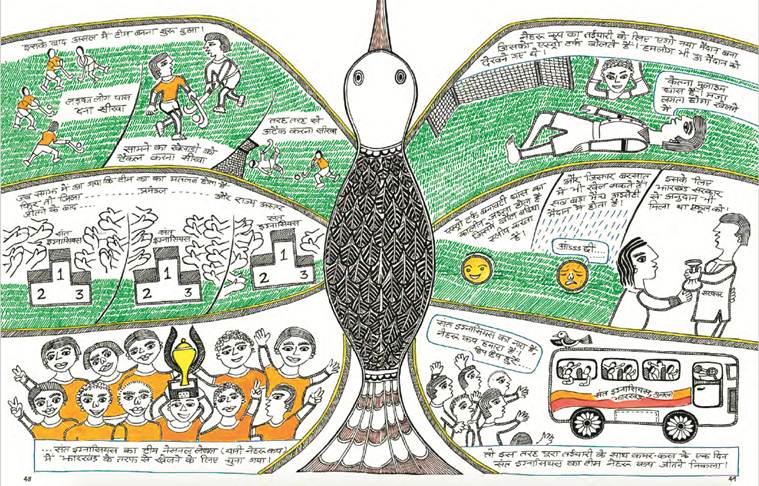
A 12-year-old boy has to leave a familiar world — his village, family and friends — behind and move to a new village to attend a missionary boarding school. It is here that he makes new friends, finds seniors and teachers who guide him, and adjusts to new norms and rituals. Life in Jharkhand’s Gumla teach him new things each day and the five years that he spends there to make the coming-of-age story of Biksu (Jugnoo Prakashan, Rs 525).
The graphic novel, for children and young adults, is the brainchild of designer Raj Kumari and her screenwriter husband Varun Grover. Its origins lie in a 35-page letter that Kumari’s cousin Vikas Kumar Vidyarthi wrote to the family, summarising his growing up years.
“In the letter, he let himself flow through his memories. He said that he felt very light and happy after writing it. He was also fascinated to notice that whoever he handed that letter to, including me, read it in one breath,” says Kumari. Grover, too, was also deeply moved, and a month later the couple started thinking of ways to transform the letter into an illustrated story.

“It had fragments of memories in no chronological order and still it had a story. When we hear the term boarding school — we generally think of posh schools in the hills but here was a story about a missionary-run school, deep in the jungles of Jharkhand, giving children a multi-layered life experience in discipline, coping with sadness, and making new relationships,” says Grover.
To illustrate the story, Kumari decided to use the folk art of Madhubani that is indigenous to Bihar and Jharkhand. A graduate in accessory design with a specialisation in Indian art and crafts, Kumari had started learning the art months before she got the letter and was practicing it by illustrating old Hindi film songs. “After illustrating a few episodes, I realised that qualities of rawness and simplicity, which were the core of that letter, were coming out effortlessly through this art. When you experience life, on the surface level it feels mundane and crude, but the deeper you go, the more abstract it becomes. I felt that Madhubani has the same quality,” says Kumari.
What also makes the book different is that it is written in chhota Nagpuri, a dialect of Hindi, spoken in Biksu’s homeland, rather than the khadi boli Hindi. “This choice now feels natural now but writing those dialogues did feel odd initially. The deep conditioning of writing in chaste Hindi was coming in the way,” says Grover. Before the story took form of a book, it was published as a series of 22 episodes in Chakmak, a Hindi magazine. The couple had received an overwhelming response then.
Children from remote villages started telling them how much they related with the emotions of Biksu. Once Sushil Shukla, who edited the magazine then, had the father of a four-year-old girl at his office, looking for a copy. “She had not received her monthly copy and the wait was unbearable for her. She couldn’t even read at that time and it was her father who would narrate the story to her,” says Kumari, adding that teacher training professionals and teachers in tribal villages in Madhya Pradesh have started using the book as a teaching tool. “A father shared that he is buying this book for his son who is soon joining a boarding school. He wanted to mentally prepare him before he left,” she says, adding that for many readers it brought back childhood memories and emotions.
It took the couple fours years to get the book published. “We went to many publishers — but most of them didn’t think that a graphic novel in Hindi, that too created with Madhubani art, makes any sense. One big publisher liked the art and story but told us to re-do the entire dialogue in khadi boli as they believed that chhota Nagpuri dialect will corrupt the tender minds of children,” says Grover.
When Sushil Shukla and Shashi Sablok moved from Chakmak to start their own magazine, Cycle, with Takshshila Foundation and Ektara India, they decided to publish Biksu in its original language and art.“Hindi literature for children is available in a good variety today, but the only thing publishers lack is marketing. But books in dialects of Hindi, say Braj, Bhojpuri, Awadhi, and Bundeli, are not being published and that hints at the purist stand of most publishers,” says Grover, who is planning another graphic series with Kumari which will “most probably be about the secret lives of cats”. The inspiration will be their own cats — Jaaneman, Dilbar
and Chhenapoda.